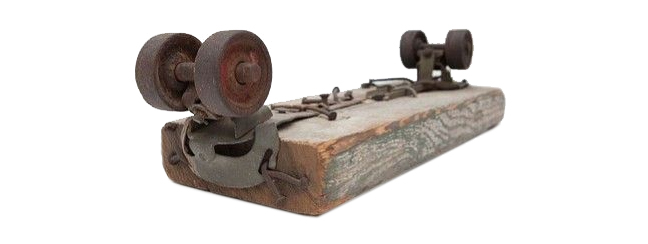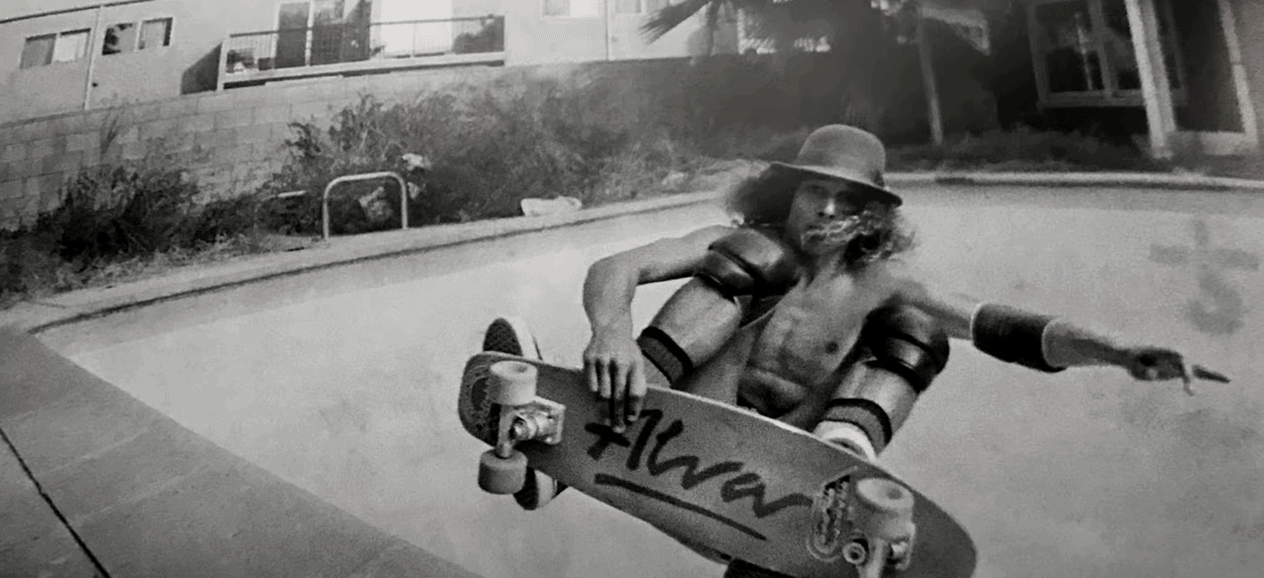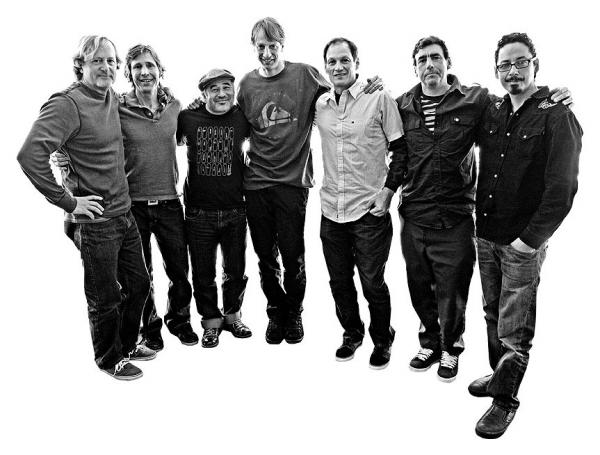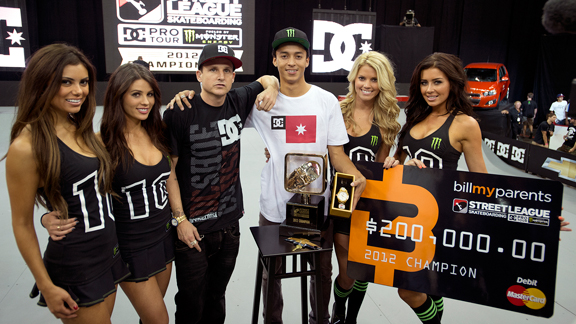Skateboarding is certainly more than 70 years old and it is now a well established discipline in the French and Western culture and mores.
Let's take a look back at these seven decades of innovations and evolutions that have brought Skateboard to where it is today: in the spotlight!
Years 50-60: Genesis
We usually situate the birth of skateboarding somewhere in the 50s, during the advent of the surf, imported in California. It is said that the first American surfers quickly thought about how to continue to slide, even when the ocean was flat.
If you look a little bit, you will find pictures of the first boards. Pieces of wood on which are nailed pieces of roller skates. No kicktails, no bearings. Needless to say, this kind of boards did not offer great possibilities to the first skaters.
Little by little, skateboards will evolve, with the addition of trucks (first fixed), then ceramic wheels and sometimes a tail.
In 1965, there are already skateboards sold in California stores. It is also known that Makaha Skateboards produced longboards in series in Santa Monica since 1963. That same year, the first advertisements for skateboards appeared in surfing magazines and the first Sidewalk Surfing contest took place in Hermosa Beach, still under the leadership of Makaha Skateboards.
March 1966, the Van Doren brothers and their associates create the VANS brand.
Until then, skateboarding remained a confidential sport, difficult and the boards were still similar to DIY that were not particularly developed to meet the needs of skateboarders.
Everything will change in the 70s.

1970s: Invention of urethane wheels and trucks with bushings
They are two major inventions which will revolutionize the skateboard from 1972: the truck and the urethane wheel!
It is Frank Nasworthy who will create the first urethane skateboard wheel (under the name Cadillac Wheels) and change forever the world of skateboarding. The contribution of the urethane wheels allows from now on to roll fast, and offer much more comfort, in particular vis-a-vis the obstacles.
From then on, the possibilities became immense and the repertoire of tricks grew. Skateboarders started to clear new territories and to invade empty pools.
At the same time, in 1975, brands such as Bennet invented trucks with rubber pivots (bushings) that offered a turning capacity that was unprecedented. This invention opens the door to new practices, including slalom.
Skateboards can now be properly equipped and skateboarders are no longer limited to sidewalk surfing. The disciplines flourish in the four corners of California and are exported to Europe. The first Downhill enthusiasts appeared and invented the slide.
In 1977, there were no less than thirty skateboard manufacturers in the USA. The Road Rider brand, already present at that time, offers wheels with sealed bearings. Kryptonic released its Star-Trac series. Santa Cruz Skateboards is created in 1973. VANS released the Slip-on in 1974, the Era in 1976 and the Old Skool in 1977.
All the ingredients were there. The Skate revolution can begin!

Creation of the Z-Boys, first Ollie, Bones Brigade
It is in this environment that the first skateboarding legends will make their appearance.
Nowadays, the Zephyr Competition Team was born in the middle of the 70's. This surf team, which represented the local Santa Monica surf shop, became famous for democratizing pool skateboarding and inventing an aerial style and a whole bunch of new tricks from freestyle that would lay the foundations of ramp, bowl and street skateboarding. Its members would become the first skateboarding celebrities under the name Z-Boys: Tony Alva, Jay Adams and Stacey Peralta were among them.
While the first skatepark was born in Port Orange (Florida), it was soon followed by others in California, and especially in Hollywood. In 1977, the young Alan Gelfand (14 years old) finally has an adequate infrastructure to develop his talents in the ramps of Hollywood and invents one of the mythical figures of skateboarding: the Ollie. Alan will later be the first to join the Powell-Peralta Team set up by Stacey Peralta and which will make the news by popularizing the first videos of Pro skateboarders under the name of Bones Brigade.
The Bones Brigade would go on to become the largest skateboarding team in the world, producing legendary videos like "Propaganda" that influenced thousands of young skateboarders.
At that time, it is estimated that there are more than 15 million skateboarders in the world.

Tony Alva Air Grab in a Pool
80's: Underground and appearance of the "Stars": Hawk, Mullen, Gonzales, etc.
Deemed a dangerous practice, skateboarding suffered a media backlash in the early 80s that led to the closure of many skateparks in the USA and Europe. The Skate becomes an Underground practice, associated with the Punk movement or Street Culture and "Trash" brands appear like Thrasher with its slogan "Skate and Destroy".
Paradoxically, it is this turn which brings to Skateboard an even more important notoriety among the young people: the Skate found an image (already well initiated by Tony Alva and Jay Adams)!
The 80's saw the emergence of skateboard brands and boards with innovative shapes adapted to the practice modes. Between 1981 and 1989, we note the appearance of dozens of companies like Transworld Skateboarding Magazine, World Industries, Venture Trucks, Spitfire Wheels, Blind, Globe or Thunder Trucks .Powell-Peralta, Vision and Santa Cruz have a stranglehold on the Skate industry.
The invention of the Ollie was emulated and completely changed the contests of freestyle. The Street is gradually making its appearance by taking possession of urban furniture and the pioneers of the genre are imposing their style: Mark Gonzales becomes Pro in 1985 and plays with Natas Kaupas to slider the stair railings.
The Bones Brigade launches new skaters who are about to mark a whole generation; Tony Hawk, Steve Caballero, Colin McKay or Rodney Mullen who becomes a professional skater in 1980. He will be attributed in the years that follow the invention of many tricks of street: kickflip, heelflip, 360° flip, casper, underflip, or darkslide (!!!).
1985, in the movie Back to the Future, Marty McFly ridicules Biff Tannen with his skateboard (which he just invented)! Bart Simpson comes out of school on a skateboard in the credits of episode 01 of The Simpsons in 1989.

The Bones Brigade reunited: Stacey Peralta, Rodney Mulen, Steve Caballero, Tony Hawk, Mike McGill, Lance Mountain & Tommy Guerrero
90s: Apotheosis, market explosion
At the beginning of the decade, the rollerblading explosion overshadowed skateboarding. A temporary crisis that will last a few years before Skateboard settles permanently as a major sport, slowly abandoning its Underground image.
The first edition of the X-Games took place in 1994, in Rhode Island, under the auspices of the American television channel ESPN. It is the first international extreme sports competition in history and Skateboard has a place of honor. The skateboard tricks become extremely technical.
On its side, the Street writes its letters of nobility in videos more and more mediatized and the new figures of the kind emmerge: Eric Koston, Paul Rodriguez or Andrew Reynolds.
Pro skateboarders become stars and earn a very good living. The "Bosses" of skateboarding become ambitious entrepreneurs and the number of new brands explodes during the decade: GIRL, Flip, Alien Workshop, Birdhouse, Chocolate, Creature, DC Shoes, Destructo, Element, Toy Machine, Zero. In France, it is the brand Cliché from Lyon which makes the beautiful days of the skateboard in the Hexagon.
411 VM is launched in 1993 and becomes the reference of skate videos in VHS until 2005. Rodney Mullen retires from competition and joins Plan B where he appears in the video Questionable in which the level is insane! Activision and Neversoft release the video game Tony Hawk's Skateboarding in 1999 on Playstation and Nintendo 64. The Ninja Turtles skateboard between two Pizzas.
2000s: In Pop Culture
Since the beginning of the 2000s, skateboarding is a discipline recognized worldwide, and the fame of Tony Hawk goes far beyond the borders of Skate.
Legendary videos are published in the 2000s, first among which Menikmati of Team Es (2000), BAKER 2G (2000), Fully Flared (2007), the first video of Team Lakai or Sorry (Flip) in 2009.
In 2002, Avril Lavigne sings "Skater Boy" and the Skateboard is totally returned in the popular culture.
Youtube is created in 2005, and all skate videos are gradually put online, sealing the fate of the last VHS / DVD magazines. The same year, the movie"Lords of Dogtown" (mentioned above), written by Stacey Peralta, tells the story of the Z-Boys and their influence on the skateboarding world.
Nevertheless, the industry behemoths are experiencing serious difficulties due to a decrease in the number of skateboarders while the number of practices are increasing on the roads and at skatepark (longboard, electric skateboard, scooter).
The Street League Skateboarding is created in 2010 by the pro skateboarder Rob Dyrdek (record holder of the longest boardslide: 30.62 m).

Nyjah Huston, winner of the 2012 SLS with Rob Dyrdek
Since 2010: Return to Strength, Olympic Games
The last decade has seen skateboarding become a "normal" sport, considered in the same way as many other major sports.
In 2020, skateboarding is even officially becoming an Olympic discipline for the Tokyo Summer Games, causing many to cringe, and perhaps finally ending what was left of the counter-culture in the skateboarding movement.
The Skate Street League competition now offers a $200,000 prize to the winner and pro skateboarders like Nyjah Huston are becoming the face of major brands like Lebron James or Serena Williams.
There have never been so many works in which a skateboard or a longboard appears (movies, clips, video games, commercials, songs).
Historic brands have returned to the forefront and some, like VANS, have experienced an unprecedented explosion in popularity between 2015 and 2022. We no longer count the stars who wear VANS on their feet or the series in which the brand appears (Stanger Things, Squid Game, etc.)
Skateboarding is omnipresent!
